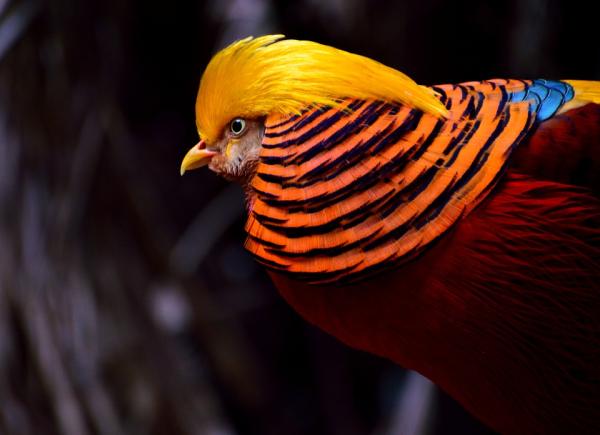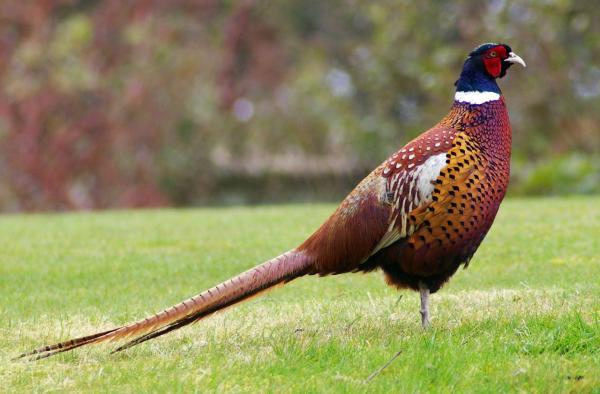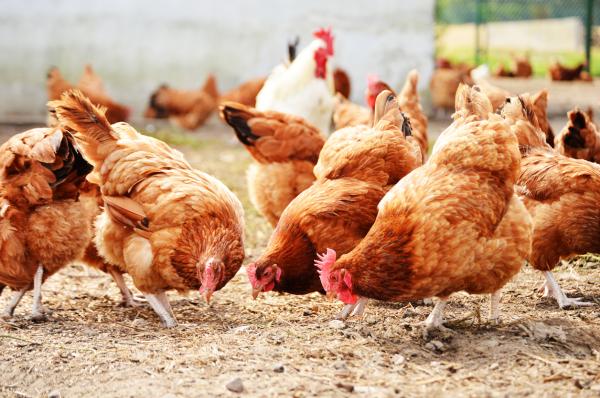
Land fowl, namely chickens, quails and pheasants, are all closely related - but that is where the similarity ends. When it comes to size, color, plumage, diet and habitat, each of these birds differs from the other. Even though all three animals reproduce by laying eggs, there are many distinguishing characteristics between these types of fowl, whether in terms of the different breeds and types or the actual size of an average bird.
Read on this AnimalWised article to know the main differences between pheasants, quails and chickens.
What are quails like?
"Quail" is a general term that includes two families, the Old World Phasianidae and the New World Odontophoridae: There are 29 species of quail, and some of them make ideal pets.
Generally considered a game bird, quails are known for their round, plump bodies and short height. Quails measure an average length of between 8 and 10 inches. Weight ranges from anywhere between 5 to 8 ounces in most commonly found wild species. Quails are also cultivated in poultry farms; their weight varies depending on whether they are bred in captivity or roam free.
Various species of quails are known for their distinctive coloring and plumage. California and Gambel's quails have a plumage that is blue-grey in color with a black and white head. The California quail has a belly that is brownish white with scaling and a teardrop plume on its head in black shades. The Gambel's quail also has a blue belly marked with cream and black bands. The mountain quail has a deeper blue coloring on the belly, neck, and chin. Bobwhite and Montezuma quails do not have plumes, and have brownish white bodies with a striking black and white face.
In the picture below you can see a pair of bobwhite quails.

What are pheasants like?
"Pheasant" is also a generic term, as it includes 49 species - and many subspecies - in the family Phasianidae, which also includes Old World quails.
Pheasants are large, colorful and long-tailed. One of the main differences between quails and chickens are their stout bills. Strong, long legs and four-toed clawed feet make up the rest of the body. Their wings are curved, short and rounded; when they sense dangers, pheasants can fly for short stretches. Male pheasants are larger than females on average, and they sometimes have spurs. Here you can learn more about the differences between male and female pheasants.
In the picture below you can see a male common pheasant.

What are chickens like?
Chickens, on the other hand, are a subspecies of the red junglefowl known scientifically as Gallus gallus domesticus. As its name indicates, the chicken is a domesticated fowl. They belong to the same family as quails and Old World pheasants.
Striking plumage and longer flowing tails, hackles and saddles make the male chicken a very colorful bird. Chickens vary in shades from bright white to blue, green, brown and even purple - since they have been domesticated for centuries, nowadays there are many different breeds. The adult rooster or male chicken has a comb distinguishing it from the hen or female chicken.
Chickens are also reared in poultry farms for their meat and eggs. Chickens live for 5 to 10 years based on the breed. The world's oldest chicken, according to the Guinness World Records is a hen who died at the age of 16.
In the picture below you can see domesticated chickens in a free-range farm.

Dietary differences between pheasants, quails and chickens
While quails and pheasants are primarily herbivorous animals, chickens are omnivores.
Quails feed mostly on leaves and seeds, but occasionally they will feed on arthropods. Their diet undergoes a transition throughout the year, when they will eat berries and roots or tubers. Different breeds of quails have different diets: for example, Montezuma quails dig up roots, bulbs, and tubers from sedges and sorrels. Certain species of quails may not require fresh water. Pheasants are also occasionally in need of alternative sources of sustenance.
Chickens feed on everything from insects to grain and young mice.
What to feed quails, pheasants and chickens
If you're feeding quails, pheasants or chickens because you keep them as pets, you will find that they have specific dietary requirements.
Quails and pheasants require more protein than you may think. Captive quails require high amounts of protein from the moment they hatch. You can feed them partridge pea, soybeans, wheat, rye, oats, cowpeas, clover, millets, mealworms and blackberries. You can also look for specific feed and supplements for fowl. These birds appreciate calcium sources such as shell grit.
If you want to feed wild or semi-domestic pheasants or quails to supplement their current diets, you should grow corn to provide them with a steady supply.
Habitat differences between pheasants, quails and chickens
Another difference between these three types of fowl is their natural habitat.
- Pheasants can be found in a wide range of areas, from grasslands to idle fields, wetlands, croplands, shrublands, and haylands. The most widespread species, the common pheasant, is native to Asia but has been introduced to all parts of the world.
- Quails can inhabit rangelands, woodlands, foothills and even suburban areas. The common quail is found across North Africa and Europe, while the Japanese quail is a separate species that evolved from it after domestication in East Asia. Both are in the family of Old World quails, which also includes pheasants.
As we said, New World quails belong to a different family. They can also be found in a variety of ranges, from deserts to rainforests. Nowadays, both types of quails have been introduced to almost every continent. - Wild junglefowl can be found in uninhabited areas with dense vegetation of the Indian subcontinent and Southeast Asia. There are four species of junglefowl, including the red junglefowl, of which the domestic chicken is a subspecies.
It is believed that the chicken was first domesticated in Southeast Asia or the Indus Valley, and it was probably introduced to Europe in the Ancient Greek period, during which it spread to Egypt and later the rest of Africa. Its breeding spread across Polynesia by the seafarers of the 12th Century. Blue-egged chickens can be found in Asia and the Americas, which suggests that domestic chickens were not introduced by Europeans.
Nowadays, the domestic chicken is found in modern urban areas or rural farms all over the world. Depending on their location and breed, chickens are known by different names, from "roosters" to "yardbirds".
In the picture below you can see a red junglefowl, the wild cousin of the chicken, crossing the road.

Quails, pheasants and chickens: Birds of a feather
The different chickens, pheasants, and quail species, subspecies and breeds also show notable differences between them. The most widespread pheasant species include:
- Common pheasant
- Golden pheasant
- Himalayan Monal pheasant
- Lady Amherst's pheasant
- Mikado pheasant
- Ring-necked pheasant
- Reeve's pheasant
- Silver pheasant
- Swinhoe pheasant
Most quail species are found in woodlands and forests, so the different types and variations depend on specific factors in the environmental habitat such as climate and landscape. Some quail species include:
- Bobwhite quail (New World)
- California quail (New World)
- Mountain quail (New World)
- Montezuma quail (New World)
- Common quail (Old World)
- Japanese quail (Old World)
- King quail (Old World)
- Rock bush quail (Old World)
- Himalayan quail (Old World)
Chickens, hens and roosters are all the same species, but there are hundreds of chicken breeds. They differ in terms of their place of origin, plumage shade, comb type, skin color, number of toes, type of feathering, size, egg shell color and more. Japanese bantam hens do not lay eggs at all, while hybrid hens can lay 280 eggs per year, nearly an egg each day. Some popular chicken breeds include:
- Buff Orpington
- Rhode Island Red
- Leghorn
- Hamburg
- Silkie
- Faverolles
- Naked Neck
- Minorca
- Scots Grey
In the picture below you can see a California or valley quail.

To sum up, the Phasianidae family includes Old World quails, pheasants and chickens, and also partridges and peafowl, which explains why they are all quite similar. New World quails are the exception, as they belong to a different family - Odontophoridae - but are called "quails" because they look and act similarly to their cousins.
The differences between pheasants, quails and chickens can be seen in their size and shape, as well as in their habitat and state of domestication. However, there are also big differences between species, subspecies and breeds, which complicates the matter.
In the picture below you can see a red-legged partridge, also in the Phasianidae family.

If you want to read similar articles to Differences between Pheasants, Quails and Chickens, we recommend you visit our Facts about the animal kingdom category.